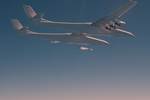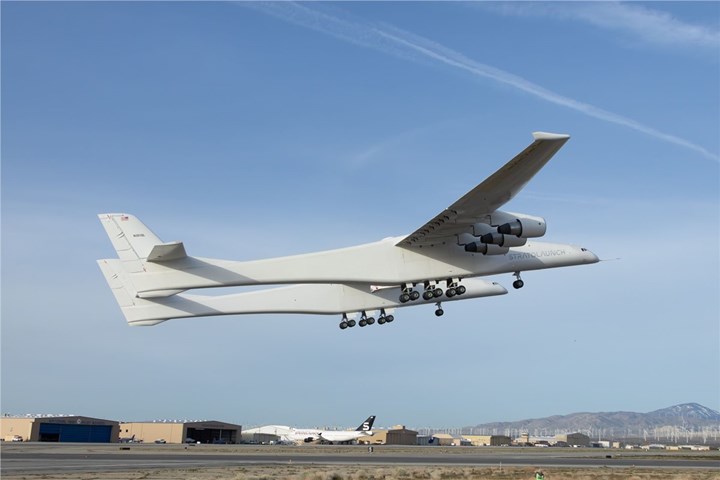Stratolaunch celebrates first powered flight of TA-1 test vehicle
Reusable hypersonic test aircraft met primary flight objectives and approached Mach 5 speed, gathering data for concurrent TA-2 and TA-3 test beds.
Stratolaunch (Mojave, Calif., U.S.) announced that it has successfully completed the first powered flight of the Talon-A test vehicle, TA-1, a privately funded, reusable hypersonic test aircraft (see video below), after its separation from the composites-intensive launch platform, Roc.
Primary objectives for the flight test included accomplishing safe air-launch release of the TA-1 vehicle, engine ignition, acceleration, sustained climb in altitude and a controlled water landing.
“While I can’t share the specific altitude and speed TA-1 reached due to proprietary agreements with our customers, we are pleased to share that in addition to meeting all primary and customer objectives of the flight, we reached high supersonic speeds approaching Mach 5 and collected a great amount of data at an incredible value to our customers,” Dr. Zachary Krevor, president and CEO of Stratolaunch, says. “Our goal with this flight was to continue our risk reduction approach for TA-2’s first reusable flight and be steadfast on our commitment of delivering maximum value to our customers. We are excited to review the data from today’s test and use it as we plan our next steps toward TA-2’s first flight later this year.”
Concurrent to TA-1 testing, Stratolaunch is progressing on the manufacturing of TA-3, the second fully reusable vehicle in the Talon-A product line. The company is also beginning modifications to its additional launch platform, the Spirit of Mojave, a modified Boeing 747-400.
According to aerospaceamerica.aiaa.org, it was decided early on in the Talon-A’s production that carbon fiber would be the material choice for the aircraft’s airframe, “not for its superior strength relative to the metal options, but for speed.” It was built in Mojave from layers of carbon fiber prepreg textiles that were hand-laid into forms, bagged and vacuum pumped, and hardened in an oven. The airframe can be easily modified or repaired — to add reinforcement to a specific part of the structure, for example.
“It was the fastest possible way [using composites] for our team to rapidly design and manufacture an airframe to go do these flights,” says Aaron Cassebeer, a longtime engineer at Scaled Composites. Stratolaunch hired Cassebeer to build the team of engineers for Talon-A, and make the reusable, rocket-powered flying testbed a reality. “Metal airframes, on the other hand, require longer lead times for tooling and setting up their assembly, plus they’re more difficult to modify once that assembly process has been set. On the plus side, it’s easier to mass produce airframes from metal. If we had been designing a system that we expected to build 100 or 1,000 of the Talon-A, it’s very possible that we would have chosen a different path.”
For related content, read “Stratolaunch TA-1 test vehicle completes captive carry flight.”
Related Content
-
Materials & Processes: Fibers for composites
The structural properties of composite materials are derived primarily from the fiber reinforcement. Fiber types, their manufacture, their uses and the end-market applications in which they find most use are described.
-
One-piece, one-shot, 17-meter wing spar for high-rate aircraft manufacture
GKN Aerospace has spent the last five years developing materials strategies and resin transfer molding (RTM) for an aircraft trailing edge wing spar for the Airbus Wing of Tomorrow program.
-
The state of recycled carbon fiber
As the need for carbon fiber rises, can recycling fill the gap?

















